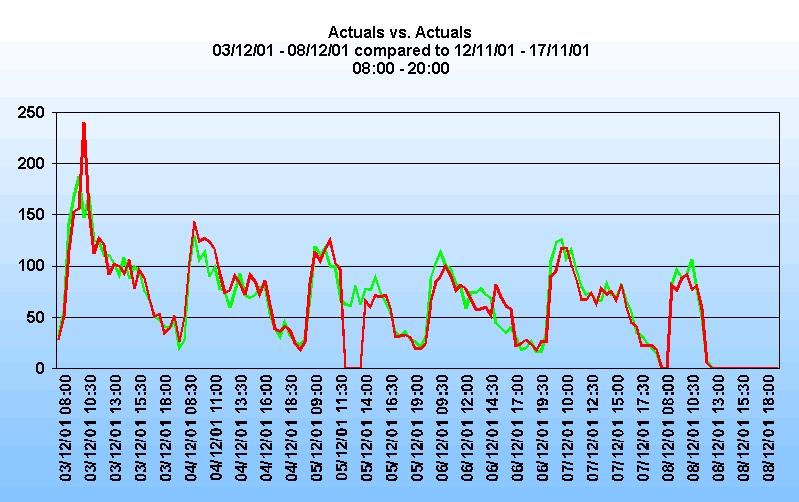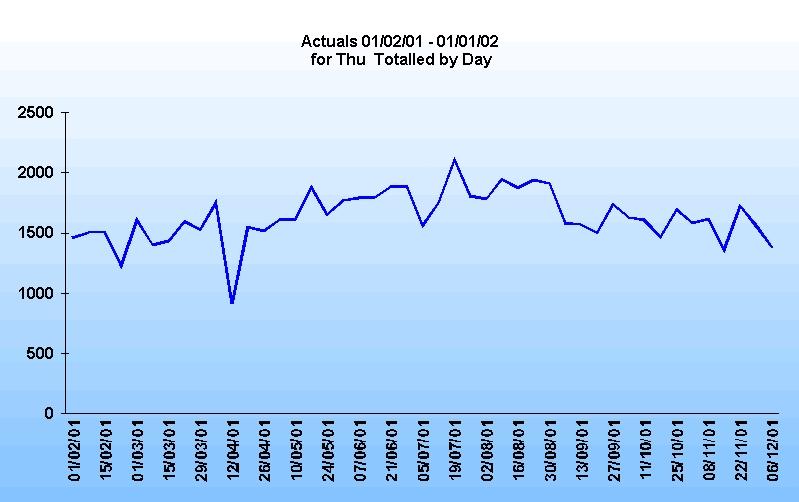In times of economic crisis and dwindling profits, it is more important than ever to ensure you are getting maximum benefit from your software investment, including your workforce management (WFM) solution. One of the biggest threats to a call center’s profit margin is wasted labor expense due to the lack of accurate WFM forecasting. Staffing operational costs account for 70 to 80% of your budget, and can be severely impacted by under- and over-staffing. Unless you are using Merlang® algorithms you will always be at risk for over-staffing.
Without proper forecasting tools, overstaffing can mean the difference between profit and loss. What causes overstaffing? Simply put, overstaffing is a result of inaccurate forecasting. The importance of accurate forecasting cannot be overstated. Accurate WFM forecasting is the foundation of call center scheduling, and without it, over- and understaffing will occur and impact the profitability of a contact center.
Accurate scheduling is dependent upon the forecast correctly estimating anticipated call volume and determining the number of agents required to meet service levels. How does this affect profitability? In a real life scenario, if call volume is underestimated to the extent that 100 callers out of 1,000 hang up before they speak to an agent in a sales environment where the average order is just $50, $5,000 in lost revenues will occur per day, $150,000 per month, or a staggering $1.8 million per year.
This paper discusses three primary components of accurate WFM forecasting:
- What determines accurate WFM forecasting?
- Variability and Predictability – what the difference means to you
- Erlang versus Merlang®
What determines accurate forecasting?
Providing the required accuracy, by taking into account all the historic and future dynamics, requires a sophisticated and accurate WFM forecasting tool. No single methodology is optimal for all circumstances; however, four factors should be taken into consideration:
- Correlated Forecasting – Only the most sophisticated systems can perform correlated forecasting — that is, forecasting for specific events such as catalog drops or other marketing events that cause wide fluctuations in the volume of calls that must be processed.
- An Integrated approach to support multi-skilled issues – It is necessary to have forecasting algorithms that directly calculate requirements in a multi-skilled environment, while avoiding repetitive analytical simulations. A single forecasted set of requirements should be generated for all inter-woven skilled activities, regardless of the type of work being offered, such as email, chat, etc. Recognizing secondary skills and accounting for call overflow to available secondarily skilled agents will help eliminate overstaffing. Forecasts that are based solely on primary skills will generally overstaff, since overflow cannot be considered as a factor.
- Collecting enough historical data – It is imperative to maintain detailed data for several years in order to produce an accurate forecast. Many workforce scheduling systems store no more than 16 weeks of historical inbound call data to generate a forecast, and most fail to gather information on marketing campaigns, billing cycles or other variables that can affect call volume.
- Algorithms that include curve mapping and pattern recognition – In variable environments, Historical Trend Analysis is the only way to ensure proper staffing. It is the only methodology that can incorporate complex historical trends in its calculations. Without pattern matching to predict customer behavior for different events, the risk of over- or understaffing increases dramatically. Historical Trend Analysis also incorporates pattern recognition for special events like promotional mailings. Each time an event reoccurs, the forecasted volume is adjusted to reflect the increase or decline in incoming work, based on past occurrences. An accurate WFM scheduling tool should be able to assign agents to multiple skills during the day, each skill associated with different queues, where each queue represents a skill set.
Variability and Predictability
The volume of work arriving in a contact center, including calls, emails, correspondence etc., is quite variable and, some would argue, unpredictable. Indeed, if we looked at a history of work arriving in a typical contact center, this belief might appear to be true. The volume of work does indeed vary over a day, from one day to the next and week on week – facts which may give the impression that the accurate WFM forecasting of future workloads is an impossible task. In reality, using the right tools can help eliminate unpredictability.
However, variability should not be confused with unpredictability. How much of this work volume is actually predictable, given the right tools, and what are the consequences of inaccurate forecasting?
Getting It Wrong
If the forecasted distribution of work is incorrect, both of these situations could occur within the same day:

Justification for the cost of an accurate WFM forecasting tool:
- Average Revenue per Sales Call x Abandoned Calls = LOST REVENUE!
There are two simple effects of getting the forecast wrong:
1. Forecasting Too High
- you have too many agents scheduled
- which means low occupancy
- which leads to agents getting distracted/bored
- which lowers agent morale and quality work, resulting in
- costing your company money
2. Forecasting Too Low
- too few agents are scheduled, contributing to
- poor customer service, long waiting times, or
- agents being overworked
- resulting in low morale and poor quality work leading to
- high number of callers abandon – possibly to go elsewhere; which means
- lost business, and
- costing your company money
The amount of lost revenue through callers abandoning can be significant, particularly in a sales environment. Consider the average revenue generated per sales call – then multiply this by the number of abandoned calls you recorded last month. The answer would probably justify the cost of an accurate WFM forecasting tool on its own!
Getting It Right
Validating your historical data – New incoming data should be compared against a previously validated set of historical data. With the right report (Figure 1), you can easily spot inaccurate or missing data for the forecast tool to ignore.

Figure 1: From this graph, we can quickly identify problem areas
Recognizing events – It is important to recognize events which have an effect on the amount, and possibly the pattern, of work arriving in the contact center. For example, Figure 2 shows a drop in call volume on Thursday 12th April 2001, which was likely due to it preceding Good Friday.

Figure 2: Previous year’s Thursday call volumes
Besides holidays, other events may include billing cycles, mail or catalog drops, advertising promotions, new business activity, competitor activity, weather issues, or external factors (TV shows, sporting events, industrial actions, etc.). The lifespan and seasonal trends of each type of event should be given consideration.
Correlating events – In the example of mail or catalog drops, similar events may occur on several occasions, but will affect work differently based on the number of letters delivered. The system must have the capacity to identify and appropriately weight these events to plan for future occurrences.
Accurate WFM Forecasting Tool – Keep these tips in mind to maximize the accuracy of the forecasting tool.
- Beware of averages: While forecasting averages is a safe bet, it is not likely to be the most accurate.
- Give the forecaster some data: The more data, the better. If the tool cannot process more than a few weeks of data, its accuracy will be compromised.
- Have realistic expectations: The tool’s predictions can only be based on what has happened historically and on what it is told will happen in the future.
- Understand how your forecasting tool works:
- How much data can it store/use?
- Can it take account for inflation due to abandoned calls?
- Can it recognize seasonal trends and growth trends?
- Can you input special event information and apply correlation factors?
- How does it accomplish all these things?
A poor forecast can result in high staffing costs and lost customer revenue, but forecast accuracy depends on many factors. The key to accurate WFM forecastign is ensuring that the forecasting tool has as much information about what happened in the past and what you expect in the future, and that it will allow you to input this information and make proper use of it.
Erlang versus Merlang®
For maximum efficiency, your software algorithms must incorporate busies and abandoned calls. Merlang® algorithms improve upon traditional Erlang-C algorithms by eliminating the assumptions that queues are infinitely long, callers never abandon the queue, and all calls have to be answered by one group of agents.
Merlang equations offer the following advanced features that are not available from software packages that use Erlang-C:
- Correct modeling of queue sizes – allows for the prediction and limiting of the number and percent of busies.
- Modeling caller abandon rates – allows for the prediction and limiting of the number and percent of abandons.
- Calls handled, a complement of busies and abandons, can be used as a service level type.
- Occupancy is calculated, and caps on it may be taken into account when determining agent requirements.
- The traditional way of expressing a service level as a percent answered within a given time.
- Accounts for indirectly occupied time of agents (bathroom breaks, supervisor queries, etc.).
- Accounts for retries of both busies and abandons.
- Accounts for skill group queue assignments, queue priorities, and overflow.
A Final Word
Companies today do not have the luxury of making purchasing mistakes. Ensuring your workforce management system produces accurate forecasts is your most important consideration. Seventy-eight percent of Pipkins’ install base was previously using a product that did not meet company requirements. Invest in a system that can perform critical functions, accommodate future needs, and maintain sufficient historical call data to generate accurate forecasts.
The Pipkins Advantage
Pipkins utilizes its own state-of-the-art algorithms since the old Erlang models are no longer applicable in today’s environment. Only Pipkins offers many of the features necessary to produce accurate forecasts, such as advanced Merlang® algorithms and the must have Mean Time to Abandoned calls (MTA) for centers. Pipkins’ premier product, Vantage Point, is simply the most accurate forecasting product on the market, enabling companies to solve complex operational issues in today’s multi-faceted enterprise workforce management environments. Featuring comprehensive forecasting, scheduling, and planning functionality for complete enterprise-wide workforce management, Pipkins gives organizations the ability to automate processes and reduce costs.
